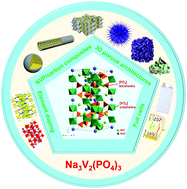Na3V2(PO4)3: an advanced cathode for sodium-ion batteries
Abstract
Sodium-ion batteries (SIBs) are considered to be the most promising electrochemical energy storage devices for large-scale grid and electric vehicle applications due to the advantages of resource abundance and cost-effectiveness. The electrochemical performance of SIBs largely relies on the intrinsic chemical properties of the cathodic materials. Among the various cathodes, rhombohedral Na3V2(PO4)3 (NVP), a typical sodium super ionic conductor (NASICON) compound, is very popular owing to its high Na+ mobility and firm structural stability. However, the relatively low electronic conductivity makes the theoretical capacity of NVP cathodes unviable even at low rates, not to mention the high rate of charging/discharging. This is a major drawback of NVPs, limiting their future large-scale applications. Herein, a comprehensive review of the recent progresses made in NVP fabrication has been presented, mainly including the strategies of developing NVP/carbon hybrid materials and elemental doping to improve the electronic conductivity of NVP cathodes and designing 3D porous architectures to enhance Na-ion transportation. Moreover, the application of NVP cathodic materials in Na-ion full batteries is summarized, too. Finally, some remarks are made on the challenges and perspectives for the future development of NVP cathodes.

- This article is part of the themed collection: Recent Review Articles


 Please wait while we load your content...
Please wait while we load your content...